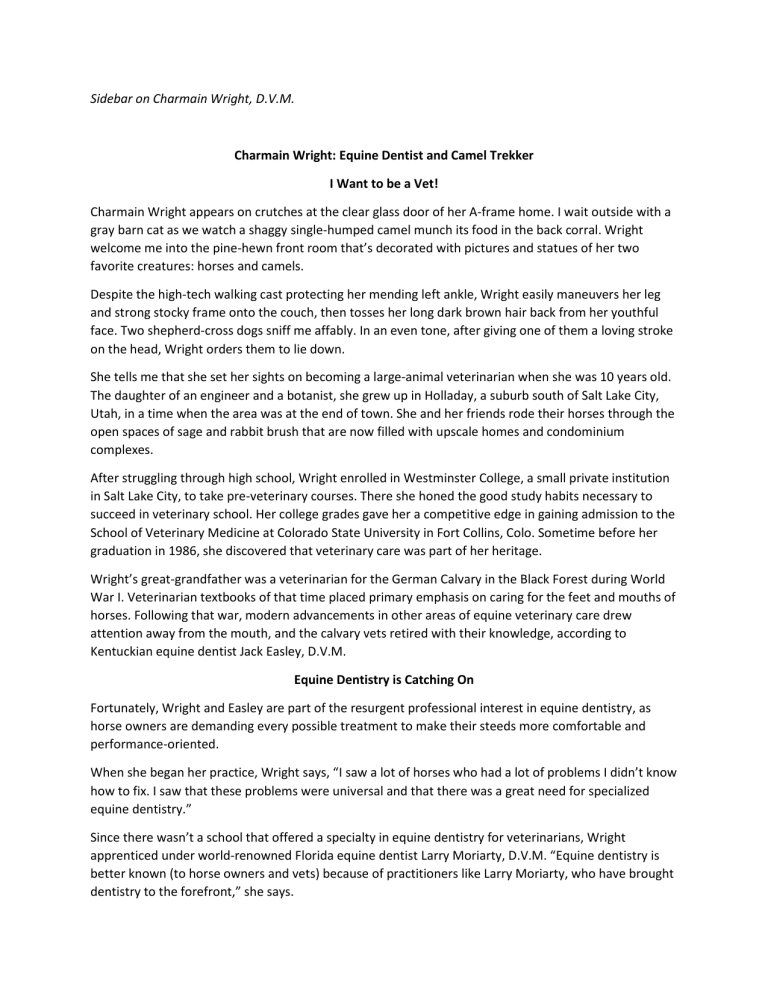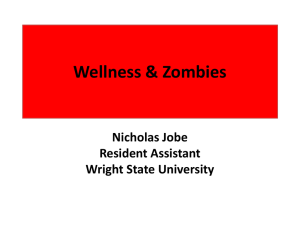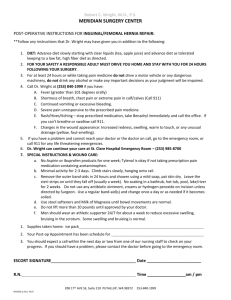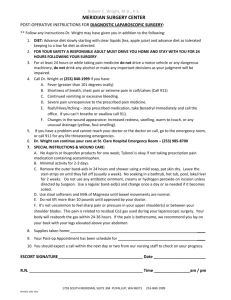Sidebar on Charmain Wright, D.V.M. Charmain Wright: Equine

Sidebar on Charmain Wright, D.V.M.
Charmain Wright: Equine Dentist and Camel Trekker
I Want to be a Vet!
Charmain Wright appears on crutches at the clear glass door of her A-frame home. I wait outside with a gray barn cat as we watch a shaggy single-humped camel munch its food in the back corral. Wright welcome me into the pine-hewn front room that’s decorated with pictures and statues of her two favorite creatures: horses and camels.
Despite the high-tech walking cast protecting her mending left ankle, Wright easily maneuvers her leg and strong stocky frame onto the couch, then tosses her long dark brown hair back from her youthful face. Two shepherd-cross dogs sniff me affably. In an even tone, after giving one of them a loving stroke on the head, Wright orders them to lie down.
She tells me that she set her sights on becoming a large-animal veterinarian when she was 10 years old.
The daughter of an engineer and a botanist, she grew up in Holladay, a suburb south of Salt Lake City,
Utah, in a time when the area was at the end of town. She and her friends rode their horses through the open spaces of sage and rabbit brush that are now filled with upscale homes and condominium complexes.
After struggling through high school, Wright enrolled in Westminster College, a small private institution in Salt Lake City, to take pre-veterinary courses. There she honed the good study habits necessary to succeed in veterinary school. Her college grades gave her a competitive edge in gaining admission to the
School of Veterinary Medicine at Colorado State University in Fort Collins, Colo. Sometime before her graduation in 1986, she discovered that veterinary care was part of her heritage.
Wright’s great-grandfather was a veterinarian for the German Calvary in the Black Forest during World
War I. Veterinarian textbooks of that time placed primary emphasis on caring for the feet and mouths of horses. Following that war, modern advancements in other areas of equine veterinary care drew attention away from the mouth, and the calvary vets retired with their knowledge, according to
Kentuckian equine dentist Jack Easley, D.V.M.
Equine Dentistry is Catching On
Fortunately, Wright and Easley are part of the resurgent professional interest in equine dentistry, as horse owners are demanding every possible treatment to make their steeds more comfortable and performance-oriented.
When she began her practice, Wright says, “I saw a lot of horses who had a lot of problems I didn’t know how to fix. I saw that these problems were universal and that there was a great need for specialized equine dentistry.”
Since there wasn’t a school that offered a specialty in equine dentistry for veterinarians, Wright apprenticed under world-renowned Florida equine dentist Larry Moriarty, D.V.M. “Equine dentistry is better known (to horse owners and vets) because of practitioners like Larry Moriarty, who have brought dentistry to the forefront,” she says.
Wright passes this knowledge along to veterinarians who have apprenticed with her. She also presents an equine dentistry slide show and discussion of clinical cases to interested vets and horse owners throughout the Intermountain West. “No matter how much you talk about the subject, you need to see it,” she says.
After five years of performing equine dentistry, clientele demand and referrals from other vets for
Wright’s expertise “could easily fill two full-time job,” instead of the fifty percent she splits between her specialty and more general veterinary practice based in Park City, Utah.
But Wright makes time to pursue other interests as well. She has won awards for creative writing and for her veterinarian column in an intermountain area publication, Rocky Mountain Horse. She and a fellow Park City veterinarian, Kimberly Henneman (who specializes in equine acupuncture and chiropractic care) are currently collaborating in writing the first equine dentistry book by veterinarians for horse owners. The book is to be published next year.
And Camels Too
Then there are the camels.
Eight years ago, Wright and her husband George spent their honeymoon on a camel excursion in
Australia. Now, Wright and Gordon have a string of six dromedary (single-humped) camels they guide on their own commercial expeditions as Park City Camel Ventures.
They have led several four-day trips during the autumn through the redrock desert landscape of the San
Rafael in southern Utah. Wright teaches her clients environmental awareness through example by carrying a long skewer which she uses to spear and collect trailside trash from atop her camel. She has also had several confrontations with “clueless” off-read vehicle riders in the area who were driving off designated trails and creating damage with their vehicles.
On one of these expeditions this fall, Wright jumped from her camel to catch the spooked mount of one of her clients, forgetting that she was seven feet off the ground. Upon landing, her left ankle took the brunt of the impact and fractured (though both the client and camel were okay). At the time of my interview, she was still conducting her veterinary practice in her knee-length walking cast.
Wright is planning to learn more about camels by attending an embryo transplant clinic this February in
Dubai, United Arab Emirates. She says she’s not particularly interested in camel breeding, but does want to associate with veterinarians who specialize in camels.
Though camels typically don’t have the dental problems of horses, Wright says she is currently treating one of her camels who has an infected tooth.
So dentistry comes around again and according to Wright, all creatures tend to benefit from a careful look in the mouth, not just gift horses.








